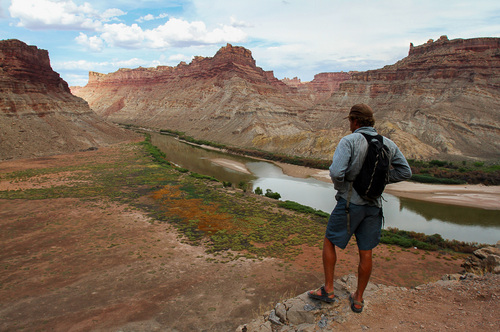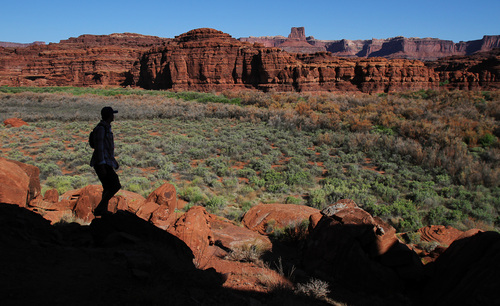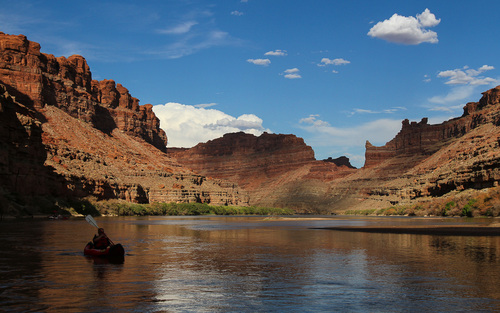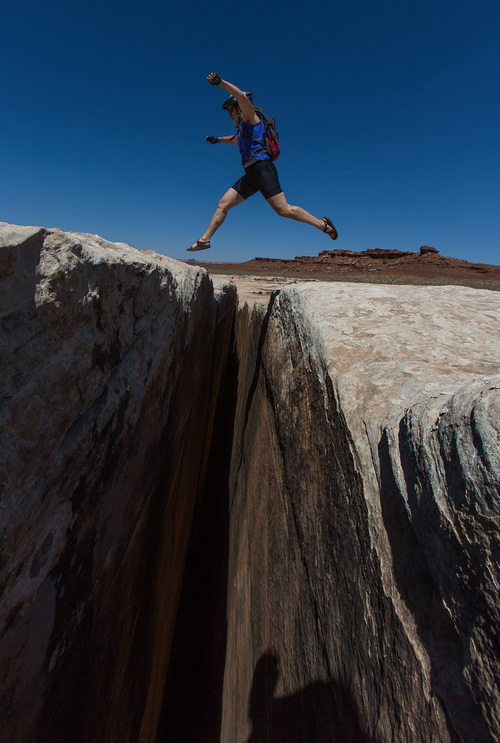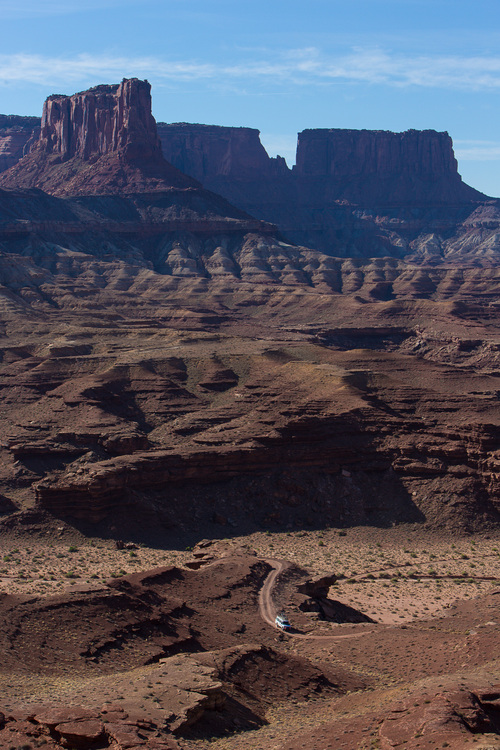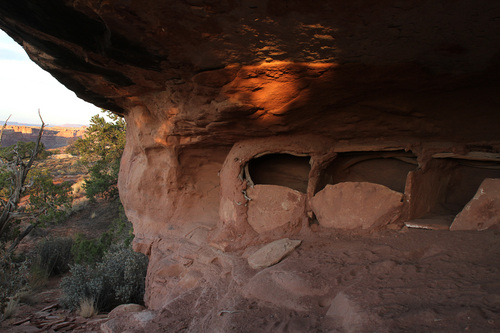This is an archived article that was published on sltrib.com in 2014, and information in the article may be outdated. It is provided only for personal research purposes and may not be reprinted.
Canyonlands National Park • A park superintendent, a national politician, a local guide.
Bates Wilson, Stewart Udall and Kent Frost played vital roles in the creation of Canyonlands National Park, overseen today by Superintendent Kate Cannon.
The park received its official designation Sept. 12, 1964, when President Lyndon Johnson made it the 31st national park in the United States. To mark its 50th anniversary, meet these four champions of the rugged, remote park in southeastern Utah.
The first superintendent: Bates Wilson
Discovering a 'proverbial pot of gold' in a 'rainbow-hued land'
Bates Wilson could have sat back and enjoyed his tenure as superintendent of Arches National Park and Natural Bridges National Monument.
Instead, he wondered about the land to the west as he drove between them on U.S. 191. When he started exploring, he later wrote:
"I found myself looking down on the most fantastic colored jumble I had ever seen. There were arches, spires, rugged canyons, crevasses and fins, stitched together with little green grabens. A large number of still-intact prehistoric Indian ruins were visible as I looked down upon this rainbow-hued land.
"To a Park Service official, it was the proverbial pot of gold."
Wilson took over Arches and Natural Bridges in 1949 and spent most of the 1950s roaming the region that would become Canyonlands with scouts, film crews, reporters and politicians. Spurred by his pleas, the National Park Service first officially surveyed the area in 1959.
At community meetings and on field trips, Wilson advocated creating a new park, a controversial effort joined by Interior Secretary Stewart Udall in 1961.
Bates "would be the first to say Canyonlands National Park was not the sole result of his work; that he was just one cog in the wheel," said his daughter, Anne Wilson. "He had a gift for bringing people together in unique ways and surmounting the obstacles."
Canyonlands National Park was officially designated Sept. 12, 1964, and Wilson was named its first superintendent a month later — becoming a rarity in the Park Service for suggesting, fighting for and eventually overseeing a new park.
He retired from the NPS in 1972 and died in 1983.
"Bates found himself in a group with a grand idea, and he and the others were right," said Kate Cannon, current superintendent of Canyonlands and Arches national parks and nearby national monuments. "Canyonlands had enchanted people for a long time and thanks to those efforts, it continues to enchant people."
The politician: Stewart Udall
Spotting a 'magnificent' park-to-be from the sky
Interior Secretary Stewart Udall first saw what would become Canyonlands at 10,000 feet, on a 1961 flight to the site of a possible dam at the confluence of the Colorado and Green Rivers. He later recalled:
"I looked off and saw this country: the Needles, the Dollhouse and all of this. I didn't say anything. I just thought, 'Goodness sake, that is a national park.' "
After meeting ally Bates Wilson, then the superintendent of Arches National Park and Natural Bridges National Monument, Udall began planning the mother of all junkets to promote a new million-acre park.
Like Wilson, he believed that if people experienced the land, they would support a national park.
Thirty-two people from government agencies and media explored via boat, jeep and helicopter and on foot from July 2 to July 5, 1961, according to a National Park Service history of the park.
Udall described the trip in a July 26, 2006, speech recorded by the NPS at Canyonlands.
"The press told [Utah Gov. George Clyde], 'We are all overwhelmingly impressed at this fantastic area. Why are you opposed to it being a national park?' " Udall said.
Clyde "waved at The Needles," Udall continued, "those wonderful stone towers, and said, 'You don't realize. This is a mining state. We might need this as building stone.' "
As critics sought to protect mining, grazing, oil exploration and other land uses, fierce debate whittled the size of the park.
In a 1962 bill, Democratic Utah Sen. Frank Moss proposed including about 330,000 acres. President Johnson signed the final version — covering 257,400 acres — on Sept. 12, 1964. With later additions, it now encompasses 337,598 acres.
Acknowledging that he was betraying the Grand Canyon in his home state, Udall told the 2006 crowd in Canyonlands that he was proud to have been a part of the creation of the Utah park.
"I still think," he said, "this is one of the most magnificent places in the United States."
The local outfitter: Kent Frost
Leading the world to 'the eerie deserts … the secret canyons'
A lifelong resident of Monticello, Kent Frost grew up exploring the canyons, creeks and crevices of what would become Canyonlands National Park.
As an eventual guide, he and his wife, Fran, led others to discover the striking landscape and helped build support for preserving it, according to "From Controversy to Compromise to Cooperation," a National Park Service history of the park.
"Frost was every person's backcountry guide, a regular guy from a local farming family who found joy amidst the region's sedimentary sculptures," wrote author Samuel J. Schmieding.
"The preferred commercial guide for official surveys, the media and tourists alike, Frost helped transfer the slickrock aesthetic and surrealistic sculptures of Utah's canyon country to everyone's living room."
Frost helped introduce Bates Wilson, then the superintendent of Arches National Park and Natural Bridges National Monument, to the region. He was on the area's first NPS survey trip in 1959. His tours for media included journalists from National Geographic and the creators of the controversial 1962 film, "The Sculptured Earth," which advocated creating the park.
The NPS rescue boat in Cataract Canyon is named the "USPS Frost" in honor of Frost, who died last year.
Frost was not as charismatic as Wilson or park proponent Stewart Udall, then interior secretary. His connection to people came from showing them the wonders of the land, which he described in his book, "My Canyonlands."
"… The racing rivers and lofty mountains … the eerie deserts … the secret canyons. Their big silence still awes me. Alone, in my earliest explorations, it used to frighten me.
"My loudest yell was scattered like raindrops on slickrock. A soft sound was magnified into unexpected importance.
"But hard desert country tempers the spirit to correspond with the elements. It drew me then. It draws me still. I must always be off somewhere … up a mountain, into a canyon, down a river.
"I have to get where I almost freeze to death in the winter. Then I can appreciate my own fireside."
Today's superintendent: Kate Cannon
'Canyonlands is here to be remote and rugged and a place of wonder'
Canyonlands wasn't only a new national park in 1964; it was also "a new park style," said Kate Cannon, its superintendent today.
"It wasn't designed to bring tourists in on trains and put them in hotels or restaurants in the park," she said. "It recognized that people didn't have to have those things to appreciate a park. That they were capable, and desired, to take care of themselves."
Cannon has been superintendent of Canyonlands and Arches national parks, and Natural Bridges and Hovenweep national monuments, since 2006.
When Canyonlands was proposed, she said, people questioned why it was needed — since Arches was already in place.
"Arches is an easy park. It is easy to visit and one of the reasons so many people come. Visitors can be utterly unprepared and fine, within limits," Cannon said.
"Canyonlands, in so many ways, is the opposite," she said. "It is remote and huge and you can get lost for a long time. Our plan is to stay that way. Canyonlands is here to be remote and rugged and a place of wonder. It is wonderful to have both and we have to preserve the difference."
Cannon sees the park enchant visitors from across the world, but it seems especially important to her that locals experience Canyonlands as well.
"It certainly works on me. I can feel it and I can see it when people look over the rim at Grand View Point," Cannon said.
"It struck me recently with an art class for kids in Grand County schools. They brought the art supplies out and sat on the rim and painted. There was some beautiful work. We talked about it weeks later and they could still describe the details. It was powerful." —
Celebrating Canyonlands
To celebrate the 50th anniversary of Canyonlands National Park, events are planned inside the park and in nearby Moab by Friends of Arches and Canyonlands Parks, supported by the National Park Service.
All events are free, but a donation is suggested.
Jen Jackson Quintano • The author of "Blow Sand in His Soul — Bates Wilson, the Heart of Canyonlands," will do readings and host a discussion beginning at 6:30 p.m. on Tuesday at the Grand County Public Library in Moab.
The Canyonlands Historic Film Festival • Being held Thursday and Saturday from 7 to 9 both nights at Star Hall in Moab. Roy Webb, multimedia archivist at the University of Utah Marriott Library, will present three films: "The Desert" by Ray and Virginia Carter; the "Rusho/Crampton Film" by Bud Rusho; and "The Sculptured Earth" by Charles Eggert.
Anniversary ceremony • The Friday event in the park is full. A birthday party will be held in the Island in the Sky district of Canyonlands.
A community picnic • Will be Saturday in Moab's Old City Park from 11 a.m. to 4 p.m. Activities include a panel discussion with original rangers in Canyonlands.
More information • Visit canyonlands50.org or bateswilson.org —
Why is it 'Canyonlands'?
Explorer John Wesley Powell designated the region as "The Cañon Lands of Utah" in the 1878 Report on the Arid Region of the United States.
By the early 20th century, the term "cañon" was anglicized, with the "n" and replaced by "ny."
The two-word terminology was used until 1962–63, when the National Park Service merged them into "Canyonlands" as the name for the new national park.
Source: "From Controversy to Compromise to Cooperation: The Administrative History of Canyonlands National Park," prepared by Samuel J. Schmieding for the NPS. —
Remembering the fight for Canyonlands
Former Interior Secretary Stewart Udall spoke in the park in 2006 about his memories of how Canyonlands became a national park.
Download a video: 1.usa.gov/1bQmRnk
Hear the audio: 1.usa.gov/1rQz18D —
Books on Canyonlands
"Blow Sand in His Soul" is a new book (Friends of Arches and Canyonlands National Parks, $18.95) tracking the efforts of Bates Wilson, then superintendent of Arches National Park and Natural Bridges Monument, to get another southeastern Utah landscape designated as a national treasure.
"My Canyonlands" (Abelard-Schuman) by Kent Frost tells the story of a local's passion with the canyon country of Grand and San Juan counties.






